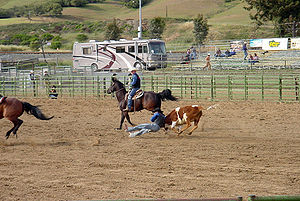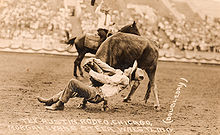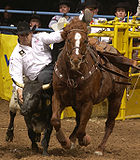
Steer wrestling
Encyclopedia

Rodeo
Rodeo is a competitive sport which arose out of the working practices of cattle herding in Spain, Mexico, and later the United States, Canada, South America and Australia. It was based on the skills required of the working vaqueros and later, cowboys, in what today is the western United States,...
event in which a horse-mounted rider
Equestrianism
Equestrianism more often known as riding, horseback riding or horse riding refers to the skill of riding, driving, or vaulting with horses...
chases a steer, drops from the horse to the steer, then wrestles the steer to the ground by twisting its horns. Like all rodeo events, there are concerns from the animal rights
Animal rights
Animal rights, also known as animal liberation, is the idea that the most basic interests of non-human animals should be afforded the same consideration as the similar interests of human beings...
community that the competition may include practices that constitute cruelty to animals
Cruelty to animals
Cruelty to animals, also called animal abuse or animal neglect, is the infliction of suffering or harm upon non-human animals, for purposes other than self-defense. More narrowly, it can be harm for specific gain, such as killing animals for food or for their fur, although opinions differ with...
. However, the event also raises a high risk of injury to the cowboy
Cowboy
A cowboy is an animal herder who tends cattle on ranches in North America, traditionally on horseback, and often performs a multitude of other ranch-related tasks. The historic American cowboy of the late 19th century arose from the vaquero traditions of northern Mexico and became a figure of...
as well.
Origins

Bill Pickett
Willie M. "Bill" Pickett was a cowboy and rodeo performer.Pickett was born in the Jenks-Branch community of Travis County, Texas. He was the second of 13 children born to Thomas Jefferson Pickett, a former slave, and Mary "Janie" Gilbert. Pickett had 4 brothers and 8 sisters...
, a Wild West Show performer said to have caught a runaway steer by wrestling it to the ground. There are several versions of the story, some claiming that he developed the idea after he observed how cattle dogs worked with unruly animals.
Modern event

Hazer
The term Hazer may refer to:*Who or which hazes , such as** The bull dogger's partner in steer wrestling, a rodeo- discipline** A senior who participates in hazing at the expense of a pledge, as in a fraternity...
, whose job is to ride parallel with the steer once it begins running and ensure it runs in a straight line, on the other side of the chute the steer wrestler or bulldogger waits behind a taut rope fastened with an easily broken string which is fastened to the rope on the steer.
When the steer wrestler is ready he calls for the steer by nodding his head and the chute man trips a lever opening the doors. The suddenly freed steer breaks out running, shadowed by the hazer. When the steer reaches the end of his rope, it pops off and simultaneously releases the barrier for the steer wrestler. The steer wrestler attempts to catch up to the running steer, lean over the side of the horse which is running flat out and grab the horns of the running steer. The steer wrestler then is pulled off his horse by the slowing steer and plants his heels into the dirt further slowing the steer and himself. He then takes one hand off the horns, reaches down and grabs the nose of the steer pulling the steer off balance and ultimately throwing the steer to the ground. Once all four legs are off the ground, an official waves a flag marking the official end and a time is taken. The steer is released and trots off.
Technique

Rules
Rules of steer wrestling include: The bulldogger's horse must not break the rope barrier in front of it at the beginning of a run, but must wait for the animal escaping from the adjacent chute to release the rope. Breaking the rope barrier early adds a 10 second penalty to the bulldogger's time. If the steer stumbles or falls before the bulldogger brings it down, he must either wait for it to rise or help it up before wrestling it to the ground. If the bulldogger completely misses the steer on his way down, he will receive a "no time".Typical professional times will be in the range of 3.0 to 10 seconds from the gates opening to the waving of the flag. The steers used today are generally Corriente cattle
Corriente cattle
Corriente cattle are a breed of cattle descended from Spanish animals brought to the Americas in the late 15th century. They are primarily used today as sport cattle for rodeo events such as team roping and bulldogging...
or longhorns, which weigh between 450-650 pounds, and the human steer wrestlers typically weigh 180-300 pounds. While steer wrestlers have a lower injury rate than bull riders
Bull riding
Bull riding refers to rodeo sports that involve a rider getting on a large bull and attempting to stay mounted while the animal attempts to buck off the rider....
or bronc riders
Saddle bronc and bareback riding
Bronc riding, either saddle bronc or bareback bronc competition, is a rodeo event that involves a rodeo participant riding on a horse , that attempts to throw or buck off the rider...
, their injury rate is higher than that of the speed events.
Animal abuse controversies
Like all other rodeo events, steer wrestling is under fire by animal rightsAnimal rights
Animal rights, also known as animal liberation, is the idea that the most basic interests of non-human animals should be afforded the same consideration as the similar interests of human beings...
advocates. Modern rodeos in the United States are closely regulated and have responded to accusations of animal cruelty by instituting a number of rules to guide how rodeo animals are to be managed. In 1994, a survey of 28 sanctioned rodeos was conducted by on-site independent veterinarians. Reviewing 33,991 animal runs, the injury rate was documented at 16 animals or 0.047 percent, less than five-hundredths of one percent or one in 2000 animals. A study of rodeo animals in Australia found a similar injury rate. Basic injuries occurred at a rate of 0.072 percent, or one in 1405, with injuries requiring veterinary attention at 0.036 percent, or one injury in every 2810 times the animal was used, and transport, yarding and competition were all included in the study. A later PRCA survey of 60,971 animal performances at 198 rodeo performances and 73 sections of "slack" indicated 27 animals were injured, again approximately five-hundredths of 1
percent — 0.0004.
However, accusations of cruelty in the USA persist. The PRCA acknowledges that they only sanction about 30 percent of all rodeos, while another 50 percent are sanctioned by other organizations and 20 percent are completely unsanctioned. Several animal rights
Animal rights
Animal rights, also known as animal liberation, is the idea that the most basic interests of non-human animals should be afforded the same consideration as the similar interests of human beings...
organizations keep records of accidents and incidents of possible animal abuse. They cite various specific incidents of injury to support their statements, and also point to examples of long-term breakdown, as well as reporting on injuries and deaths suffered by animals in non-rodeo events staged on the periphery of professional rodeo such as chuck wagon
Chuckwagon
A chuckwagon or chuck wagon is a type of wagon historically used to carry food and cooking equipment on the prairies of the United States and Canada. Such wagons would form part of a wagon train of settlers or feed traveling workers such as cowboys or loggers.In modern times, chuckwagons feature...
races and "Suicide Runs." However, in terms of actual statistics on animal injury rate, there appear to be no more recent independent studies on animal injury in rodeo than the 1994 study.
However, groups such as People for the Ethical Treatment of Animals
People for the Ethical Treatment of Animals
People for the Ethical Treatment of Animals is an American animal rights organization based in Norfolk, Virginia, and led by Ingrid Newkirk, its international president. A non-profit corporation with 300 employees and two million members and supporters, it claims to be the largest animal rights...
(PETA) notes incidents of animal injury, including an incident where a "bull [sic] suffered from a broken neck..." According to the ASPCA, practice sessions are often the scene of more severe abuses than competitions.
External links
- Pro Rodeo Online Steer Wrestling

